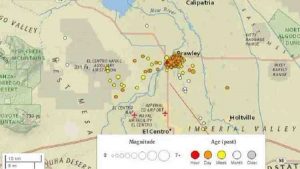
More than 250 small earthquakes have struck since New Year’s Eve near the California-Mexico border, causing unease among residents and attention from scientists.
The strongest earthquake in the sequence was magnitude 3.9, directly underneath Brawley, about 170 miles southeast of Los Angeles.
The earthquakes struck in the southern end of the Brawley Seismic Zone, a seismically active region where tectonic plates are moving away from each other and the Earth’s crust is getting stretched out “and basically adding land,” said Caltech seismologist Egill Hauksson.
The Brawley Seismic Zone is particularly important to watch because it is the region that connects the San Andreas and Imperial faults, both of which can produce damaging earthquakes. The seismic zone extends about 30 miles from Brawley, across the Salton Sea’s southern half, and ends near Bombay Beach.
Hauksson was closely monitoring the quakes that began Saturday, as there was a chance that an earthquake of magnitude 5 or larger could be triggered.
“There’s always reason to be concerned for a bigger earthquake,” Hauksson said. But by Sunday night, the possibility of the quakes triggering a larger event had largely receded.
The southern Brawley Seismic Zone is close to the Imperial fault. The Imperial fault has caused two major earthquakes in recent decades.
In 1979, a magnitude 6.5 earthquake shook El Centro, injuring 91 and causing so much damage to the concrete Imperial County Services Building that it had to be demolished.
There was major damage to the irrigation system in the Imperial Valley, a desert region that is a prolific producer of salad vegetables during the winter. Levees lining the All-American Canal, which funnels water from the Colorado River, collapsed along an eight-mile stretch.
The magnitude-7.1 earthquake that hit El Centro in 1940 killed nine people and swayed buildings as far away as Los Angeles. Irrigation systems were damaged, and railroad tracks were left warped where they crossed the fault.
Earthquakes that occur in the other end of the Brawley Seismic Zone – to the north – could trigger a major event on the San Andreas fault, one of California’s most dangerous, that could send catastrophic shaking into Riverside, San Bernardino and Los Angeles counties.
In late September, earthquakes began in the northern Brawley Seismic Zone, with three measuring above magnitude 4. That event led the U.S. Geological Survey to warn that chances of a magnitude 7 or greater earthquake on the San Andreas fault had risen as a result..
Another series of small earthquakes, topping out at magnitude 3.5, struck the town of Niland near the eastern shore of the Salton Sea on Halloween.
The last major earthquake to hit Brawley was in 2012, registering at magnitude 5.4.
Brawley Mayor Sam Couchman said the earthquakes have placed the city of 26,000 on edge since Saturday afternoon. The combination of the earthquakes and New Year’s pyrotechnics spooked some of the town’s dogs, who went missing, he said.
“We’re just kind of listening to it, and when you can hear it coming, it’ll rattle things,” Couchman said. “Last night, we had the rain, the earthquakes, and the fireworks.
“All we needed were frogs and locusts.”
Note: The above post is reprinted from materials provided by Los Angeles Times, Distributed by Tribune Content Agency, LLC..










